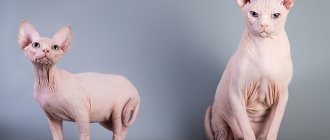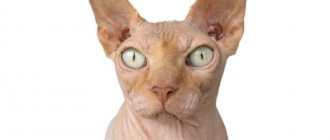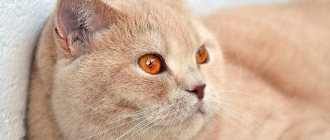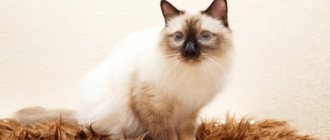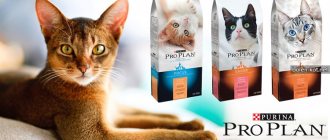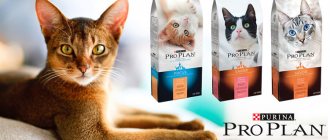Despite their atypical appearance for felines, sphinxes continue to win our hearts, becoming more and more popular among cat lovers every year. However, hairless cats continue to be quite rare due to the limited gene pool.
Why the Sphynx cat is still a curiosity, where hairless cats come from, what kittens from a Sphynx and an ordinary cat will be like, as well as many other features of the breed varieties will be covered in this article.
Varieties of Sphynxes - breeds with photos and names
If you still think that the Sphynx is one breed, then this article is for you. Officially, felinological associations recognize three varieties of hairless cats. We will talk about them in this article.
Note! There are also breeds of hairless cats that are not recognized by felinological associations. For example, the Bambino (a cross between the Sphynx and the Munchkin) and the Ukrainian Levkoy.
Canadian Sphynx (moon cat)
Canadian hairless cats have become the standard among other branches of hairless cat breeds. The founder of the breed in 1975 was a completely hairless kitten born from a short-haired mother.
A little later, his hairless sister was added to the first one, born a year after the significant birth of the most famous hairless cat. The naked babies were bought by the Z. Stardust nursery, the first hairless kittens became the founders of the most elite branch of the breed, their descendants are distinguished by their impeccable exterior and unparalleled “velor” skin.
Don Sphynx
Donchak is a much younger breed than Canadians. Don or Rostov hairless cats are a domestic breed, bred in Rostov-on-Don, recognized much later than their hairless overseas relatives from Canada. As an independent breed, Rostov Sfin cats received recognition in 1980.
Peterbald (Petersburg Sphynx)
One of the youngest branches of the Sfin cat breed is considered to be a breed bred in St. Petersburg. A new branch was created by crossing an Oriental cat and a Donetsk Sphynx in 2003.
Is it true that there are no allergies to hairless cats?
The most persistent and harmful myth is that hairless cats are hypoallergenic. People believe they are allergic to cat hair, and adopting a hairless pet seems like a good solution. Unfortunately, most often the allergy is caused by a special protein that is found in the saliva, urine and skin secretions of cats.
The Sphynx's skin contains sebum, a protective skin lubricant. This brown substance may be an allergen. If a person is allergic to cat saliva or fur, then he will be able to live in an apartment with a naked pet. All you need to do is wash your hands thoroughly after touching the cat.
Hypoallergenic? what are you saying?
Features of cats without hair
According to legends, the Egyptian Sphynx cat escorted the souls of the inhabitants of Ancient Egypt to the afterlife. According to legends, among the Aztecs, unusual hairless cats with large ears evoked reverence and respect. Allegedly, Aztec cats lived at temples, and the Aztecs revered hairless cats with large ears as divine beings.
The owners of modern Sfin cats jokingly prefer to classify their pets as alien creatures. Some owners simply say that sphinxes are magical cats. By the way, it’s hard to disagree with this statement. Everyone has long known the healing abilities of cats: cats find a sore spot on their owner, diligently knead it, massage it, and then lie down on the source of pain to warm it with their natural warmth. So, among Sfin purrs, these abilities of home healers are doubled due to the contact of the hot skin of a hairless cat with human skin.
Cats without fur need to be fed more often than their furry relatives. To maintain the necessary thermal balance of the body, the Sfin cat requires more frequent feeding and much more food than a purring cat with fur.
Sphynx body temperature
As for small hairless kittens, the normal temperature for them is 38.5-39.5⁰C. Metabolism in babies is higher, metabolic processes occur faster than in adult animals, therefore the normal body temperature in kittens is higher than in mature individuals.
In adult hairless cats and hairless cats, the normal body temperature is 38-39⁰C.
Do sphinxes have mustaches?
Many sphinxes either have no whiskers at all, or they are broken off or curled. In some Sphynx cats the whiskers fall out and grow back. Moreover, the process of loss and regrowth of whiskers in Sfin cats is a very individual matter, not amenable to any predictions.
In the language of zoologists, cat whiskers are called vibrissae; for purrs, this simple-looking device works both as protection from external dangers and as a means of navigation.
Cats are nocturnal animals and love to hunt in the dark. To recreate a complete picture of the environment, the cat uses sensitive antennae, with which it is able to detect air currents and vibrations.
If a cat's whisker touches any object, the purr will immediately trigger a defensive reaction - the cat will reflexively close its eyes. What if the obstacle touched by the vibrissa turns out to be a sharp branch, wire or some other dangerous object? Nature took care of the soft-footed meowing hunters, providing them with an additional organ of touch in the form of sensitive vibrissae.
Any Sphynx cat, although a representative of the cat family, is not a night hunter. A hairless cat is unable to survive either in the wild or on the street: it is an exclusively decorative creature bred to be kept at home. Such a pampered, whimsical animal does not particularly need a hunting attribute in the form of sensitive long whiskers.
Sphinx tail
The tail of a healthy animal should be flexible and mobile, thick at the base, gradually tapering towards the tip. Sphinxes often curl their sensitive whip-like tail into a ring, which adds even more mystery and piquancy to their unusual appearance. At the tip of the tail, sphinxes are allowed a “lion tassel” - a small tuft of hair.
Unfortunately, this part of the body in hairless cats can be problematic and bring a lot of inconvenience to the pet and its owner.
- Problem one: Anomalies, deformations and other defects of the tail, both congenital and acquired. A Sphynx of any breed that has an underdeveloped, deformed or broken tail will not be allowed for breeding. But that’s not so bad – not all pets can be the stars of a show. The trouble with congenital tail deformation is that a “broken” tail may turn out to be the tip of the iceberg, under which many diseases are hidden that threaten the health and even the life of the animal.
- Problem two: Angular cystic acne, acne, comedones. Both young animals during puberty and mature animals actively involved in breeding are susceptible to these unpleasant skin diseases.
The first of these misfortunes disfigures the cat's tail; angular cystic acne results in persistent scars that are almost impossible to remove with any absorbable ointments.
On the affected areas of the skin, cystic cavities filled with pus are formed; the inflamed foci can merge with each other and open out through the fistula tracts. The disease lasts a long time; a shell of keratinized skin particles and exudate forms on the inflamed areas.
Acne and comedones are more often observed in hairless (rubber) cats. To prevent acne, hairless animals are bathed in a decoction of chamomile or string. Also, do not forget to regularly wipe your pet’s tail with a special degreaser.
Do Sphynxes have fur?
Yes, there are.
According to the breed standard, only the Canadian Sphynx does not have varieties with fur. The animal's skin should have only minimal invisible fluff. There is short pubescence on the muzzle.
But domestic cats - the Peterbald and the Don Sphynx - according to the breed standard, allow individuals with different types of hair. We will talk about them in detail in the next section.
Did you know that a hairless cat can give birth to a fluffy kitten? In some individuals it falls out over time, while others remain fluffy.
Types of Sphynxes with fur
These types apply only to St. Petersburg and Don sphinxes:
- Brush . The coat of the Brush species can be either hard or soft and silky to the touch. The length of the hair is 2-3 mm. The coat can be straight and wavy, or crimped and hard, reminiscent of an old brush that has served its purpose.
- Flock . The skin of a flock animal is covered with tiny short hairs, reminiscent to the touch of a peach skin. As a rule, flock cats walk “in clothes” made of peach fluffs until they are 1.5-2 years old, then they completely “undress”.
- Velor . If you touch a velor seal, you are left with the feeling of touching velor or thin, very high-quality suede. The length of the hair is 2-3 mm. The fibers of velor individuals are much more noticeable than the tiny flock, barely visible to the human eye.
Why are sphinxes bald?
Genetics played a major role in the development of hairless cat breeds. Sphynxes are cats without hair, bald, cute mutants with an unusual appearance caused by the hairlessness gene. This mutation gene has long been tested by felinologists for stability, however, a hybrid of a Sfin cat and an ordinary cat is not always born bald.
Vaccination
Sphynxes kept at home run the risk of becoming victims of viral and infectious diseases no less than their street counterparts. To protect cats of this breed from dangerous diseases, their care should include routine vaccination.
They are regularly vaccinated with a complex drug that stimulates the development of immunity to panleukopenia, calcivirosis and rhinotracheitis.
This is done for the first time when the kitten is 7-8 weeks old. After 4 weeks, the sphinx is revaccinated against the same diseases and against rabies. In the future, the cat is vaccinated annually, regardless of whether it is exclusively kept in an apartment or is on the street.
Important! Before vaccination, the animal must be subjected to antiparasitic treatment. Anthelmintic drugs are given to the cat 2 times with an interval of 10-14 days. The dose is calculated based on the pet's weight.
How does a Sphynx get along with other cats?
Hairless cats and cats get along well in pairs with individuals of their own species. Touchingly hugging their paws, they love to cuddle, lick each other and show mutual care in every possible way.
Sphynxes have a friendly character, so they do not get into trouble with other pets and do not arrange for division of territory. The only thing that a bald cat cannot share with another cat is the love of its owner. Sfin cats require more attention to themselves than other pets.
“Master, have as many cats as you want, but love only me!” - this is the motto of the naked cat.
Color
There are various colors of hairless cats:
- plain (snow-white, charcoal, orange, bluish-gray, pink, purple, brownish);
- bicolor (gray-white, lilac-gray, brown-chocolate);
- with a pattern of various shades (tabby);
- tortoiseshell (black-red, cream-blue, cream-lilac);
- piebald (colored spots on a white background);
- colorpoint of various color combinations.
Silver colors of the Sphynx are not possible due to the lack of hair.
The variety of shades leads to the unique color of the skin of each individual. Having sunbathed a little under the sun's rays, the pet will look even more elegant, but such procedures should not be overused.
How much does a hairless cat cost - price in Russia
Only three breeds of hairless cats are officially recognized by feline dog associations:
- Canadian Sphynx. The price of a kitten, depending on the class and elite status of the parents, varies from 8 to 100 thousand rubles.
- Don Sphynx. The price of a kitten varies from 9,000 rubles to 30,000 rubles.
- Peterbald. The cost varies from 5 to 25 thousand rubles.
There are also unrecognized breeds of hairless cats, for example, the Ukrainian Levkoy or the Bambino. However, despite the “unrecognition”, you won’t be able to buy a hairless cat on the cheap. Bambino will cost an average of 20-50 thousand rubles, and Ukrainian Levkoy - 10-20 thousand rubles.
Behavior
A common feature of representatives of hairless cats is an affectionate, flexible, friendly character. In this way, hairless cats are similar to dogs. They are affectionate and do not tolerate loneliness or change of environment well.
Some individuals can be trained, for example, they can bring light objects to their owner. They are distinguished by their intelligence, curiosity, and understanding of human speech.
They get along easily with small family members and pets. Many owners note that keeping such pets helps maintain a comfortable, relaxing atmosphere in the house.
Pros and cons of sphinxes
Positive aspects include the high intelligence and docile nature of hairless cats, their affection and devotion to their owners - it’s not for nothing that sphinxes are called “kissing” cats.
Some breed lovers consider the negative aspects of keeping sphinxes to be their increased love for tactile contact. Occasionally this “alien miracle” shows excessive intrusiveness; not all people will like a cat’s butt sitting on their own face. By placing his hot butt on the owner’s head, or even on the owner’s “face,” the naked cat believes that in this way he will express his boundless love much more clearly. And you will have to come to terms with this - the cat is a “kisser”...
Character
Although the breed has a repulsive appearance, the character of sphinxes is very friendly by nature and absolutely not aggressive; they are extremely rarely evil.
Cats love to play with toys, so owners will need to frequently clean up scattered objects after their pets.
The behavior of the sphinx is ideal; the pet does not have the habit of causing mischief at home. These animals love human attention. I especially like it when people talk to the cat.
Separation from household members is very difficult for these creatures; it is typical for the nature of this breed to fall into depression due to lack of communication. After something bad happens in the house, cats become lethargic.
They are by nature very vulnerable. Therefore, the owner should choose company for his pet during a long departure. Sphynxes get along well with other animals. By the way, the bald cat is not afraid of dogs at all.
These animals easily get along with children and participate in children's games without resistance. They do not shy away from guests and often demonstrate to guests their skills in eating food using their front paws. And this is not all the talents of these intelligent animals.
These cats can be trained and then they can bring objects in their teeth to their owner, open doors, etc. The cat quickly learns the ability to go to the litter box; you just need to show him where he is once.
The owners must raise the sphinx without shouting or assault - he will not understand the reason for such treatment. It is better to give your speech a strict emotional tone, which the cat catches best.
But the breed has no hunting instinct. This is due to its decorative nature. Representatives of the breed do not have whiskers, so they will not be able to survive on the street.
The history of the origin of the breed - how hairless cats appeared
The first Don Sphynxes appeared from a half-haired cat of unknown origin, which was found in a trash heap by a kind-hearted Rostov woman. The woman tortured the found half-sphynx with procedures aimed at restoring the fur until she came to terms with the fact that no medicines or ointments help return the coveted fur to the found purr. In the end, the pussy was left alone, and later she brought hairless kittens from an ordinary short-haired cat, which became the founders of the breed of the first domestic sphinxes.
A similar story happened in Canada, when a hairless mutant kitten was accidentally discovered on a farm. “Rostovite” and “Canadian” are two opposite branches that have different genotypes; these two types of sphinxes do not cross with each other.
There are persistent rumors among felinologists that the first hairless cats could have appeared much earlier than the relatively new breed of hairless cats - the Canadian Sphynx cat. Strange cats without hair were noticed by the British at the beginning of the last century, but then there were difficult times in England, people were not interested in breeding “mutants with an alien appearance.”
Preparing for the arrival of a kitten
In order for the process of weaning from its mother to take place without damage to the physical and psychological health of the little sphinx, it is taken to a new home no earlier than three months of age.
Representatives of this breed are usually reserved long before they are 12 weeks old. Therefore, happy owners have enough time to learn more about the features of caring for a kitten and prepare for its arrival.
To create decent living conditions for a hairless baby, they buy a “dowry” in advance:
- bowls for water, dry and wet food;
- carrying bag;
- tray with filler;
- scratching post;
- toys;
- grooming tools (nail clipper, toothbrush, etc.);
- hygiene products (ear cleaning lotion, toothpaste, etc.);
- bed or house.
In order to provide the little sphinx with not only proper care, but also safe living conditions, the apartment is also prepared for his arrival. Wires, indoor plants, household chemicals, fragile and small objects are hidden in advance from a curious and playful kitten.
On a note. When kept at home, inquisitive sphinxes try to explore every corner of their new property and often get into the most unexpected places like the oven or washing machine. To avoid tragedies, it is better to keep the doors of these devices closed, and before using the equipment, it is better to look inside once again to make sure that there is no little prankster in there.
Interesting facts about Sphynx cats
- A naked cat is a “kissing” cat! The owner of a loving Sphynx should come to terms with this fact, because a hairless pet constantly requires communication and tactile contact. Sfin cats love to lick the hands of their owners - this is how they show their love.
- Sfin cats are extremely jealous. No, they are not at all against other pets. It's just that hairless cats want their owner to love the Sphynx more than other pets.
- Hairless cats love to cuddle.
- In addition to the well-known types of breed varieties (Canadian, Donskoy, Peterbald), there are several interesting varieties of hairless cats - Bambino, Ukrainian Levkoy, Elf, Dwelf, Cojona, Minskin.
- What kind of kittens will be born if you cross a Sphynx with an ordinary cat? Mixed half-sphinxes will be attractive in appearance, but they are unlikely to fully meet the breed standard - in this case, outbred genes will not add advantages to the animal’s exterior. However, kittens born from a half-sphinx will be carriers of the hairless gene.
The right diet
In order for the Sphynx to develop well and remain healthy longer, it is provided not only with proper maintenance and care, but also with balanced feeding. To remain active and maintain body temperature, hairless cats require more high-calorie food than representatives of shaggy breeds.
On a note. If the Sphynx's diet is low in fat, the animal will become cold and begin to overeat to make up for the lack of energy. And this is fraught with digestive problems.
With the industrial type of feeding, high-calorie products of premium or super-premium class are purchased for sphinxes. Before making a choice, you need to carefully study the description of the composition and make sure that it has sufficient fat content and there are no questionable components.
The following criteria are met:
- Royal Canin;
- Acana;
- Grandorf.
With a natural diet, the Sphinx's menu is designed so that it contains at least 70% meat. Also included in the diet of cats of hairless breeds is:
- boiled offal;
- porridge with water;
- vegetables;
- eggs;
- dairy products;
- lean sea fish.
It is important to ensure that cats of this breed never eat bones, baked goods, sweets, smoked meats, pickles and sausages. Also, sphinxes should not be given mushrooms, onions, river fish, fresh milk and any leftovers from the master's table.
Photo
Nutrition
It is very important to discuss your unusual pet's diet with your veterinarian. It can be based on Royal Canin for cats, formulated taking into account the characteristics of this breed. You can choose another complete composition of good quality.
If the owner prefers to feed his pet natural food, then it should contain a lot of protein (offal, meat) with the addition of cereals and dairy products. In addition, caring for a Sphynx involves the following procedures:
- nail trimming;
- rubbing the eyes;
- ear cleaning;
- bathing.
Raising a pet
Such cats have developed intelligence; they quickly understand what is required of them. In addition, the character of the Sphinx makes him obedient, attentive, and unforgiving. It is better to prevent negative consequences with cats in advance. Raising such animals is simple, but using punishment is impossible. They do not submit to physical pressure and do not tolerate mental violence well. It is extremely difficult to achieve anything from a cat using such methods. It is necessary to start raising a kitten in early childhood, the earlier the better. But you can start training at a later age.
